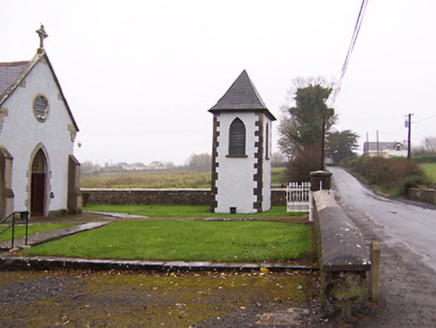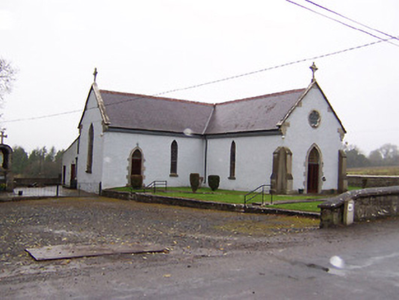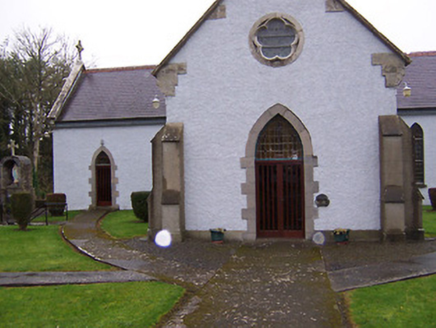Survey Data
Reg No
15400614
Rating
Regional
Categories of Special Interest
Architectural, Artistic, Social
Previous Name
Lacken and Leney Catholic Church
Original Use
Church/chapel
In Use As
Church/chapel
Date
1810 - 1880
Coordinates
237401, 264045
Date Recorded
16/11/2004
Date Updated
--/--/--
Description
Freestanding Roman Catholic chapel on T-shaped plan, built c.1820 and altered c.1880 and c.1923. Comprises single-bay nave, two-bay transepts to east and west and a shallow chancel to the rear (northwest). Pitched natural slate roof with projecting eaves course, red ridge tiles and raised limestone verges (with fractables) with cut stone Celtic cross finials over. Roughcast rendered walls with flush ashlar limestone plinth to base and rendered clasping buttresses to corners of entrance front (southeast). Pointed-arched window openings to nave and transepts, cinquefoil window with stained glass and cut stone surround above main doorcase to southeast side of nave. Triple-cusped lights with Harry Clarke Studios (c.1923) stained glass windows and cut stone surrounds to chancel gable. Pointed-arch doorcases to centre of southeast end of nave and to south and north ends of east-facing elevation of transepts, all with cut stone surrounds, modern timber glazed double-doors and overlights. Interesting interior with timber kingpost roof with trefoil decoration and marble Gothic-style altar goods (c.1915). Freestanding two-storey bell tower on square-plan to east of church with hipped slate roof, roughcast rendered walls with cut limestone block quoins to corners and pointed-arch openings to belfry (second storey) with timber louvered vents. Church and bell tower set back from small country road in own grounds to the west of Multyfarnham. Rubble limestone boundary wall with two ashlar limestone gate piers (on square-plan) with ashlar coping over and a pair of cast-iron gates and a cast-iron pedestrian turnstile gate to road-frontage (southeast).
Appraisal
An appealing early nineteenth-century Roman Catholic chapel, which retains its early form and character and much of its early fabric. It is simple, almost vernacular, in form, which is indicative of the restrictions and the relative lack of resources available to the Roman Catholic Church at the time. However, the cut stone detailing, the cinquefoil window and the clasping buttresses are unusually elaborate features for an early Roman Catholic church and may date to a mid-to-late nineteenth-century renovation. The freestanding bell tower is an interesting reminder of the Penal restrictions in force in Ireland prior to Catholic Emancipation in 1829, a time when Nonconformist churches were not entitled to have a bell for worship. Subsequently, it is common to find later detached bell towers associated with Roman Catholic churches built prior (or sometimes just after) this date. The bell tower here was in place by 1836 (Ordnance Survey map). The fine stained glass windows by Harry Clarke Studios (Dublin c. 1923) and the attractive, if simple, Gothic-style altar goods, date to early twentieth-century renovation and are of artistic merit. The good cast-iron gates and gate piers add to the setting and complete this attractive composition.





